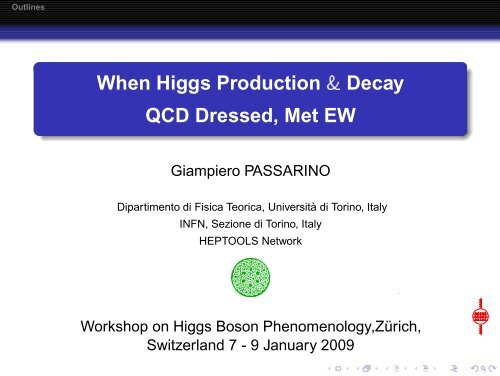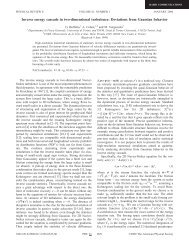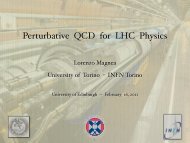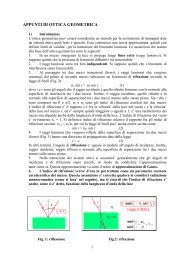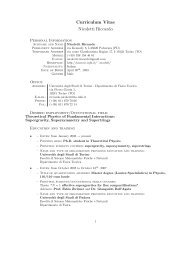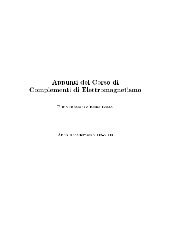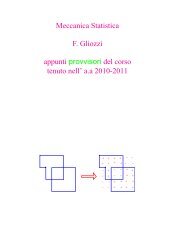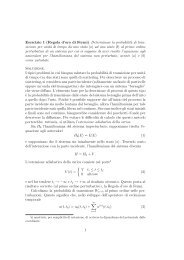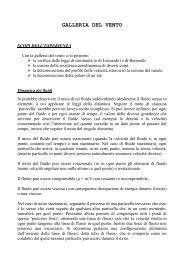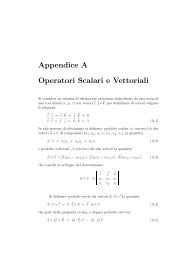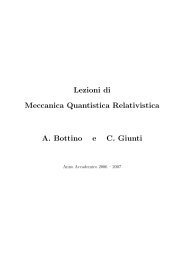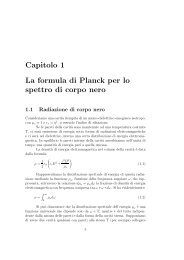QCD Dressed, Met EW - INFN - Torino Personal pages
QCD Dressed, Met EW - INFN - Torino Personal pages
QCD Dressed, Met EW - INFN - Torino Personal pages
You also want an ePaper? Increase the reach of your titles
YUMPU automatically turns print PDFs into web optimized ePapers that Google loves.
OutlinesWhen Higgs Production ¡ Decay<strong>QCD</strong> <strong>Dressed</strong>, <strong>Met</strong> <strong>EW</strong>Giampiero PASSARINODipartimento di Fisica Teorica, Università di <strong>Torino</strong>, Italy<strong>INFN</strong>, Sezione di <strong>Torino</strong>, ItalyHEPTOOLS NetworkWorkshop on Higgs Boson Phenomenology,Zürich,Switzerland 7 - 9 January 2009
OutlinesBased on work done in collaboration withStefano Actis,Christian Sturm and Sandro UcciratiThanks: M. Grazzini, M. Spira, P. Kant¢
OutlinesOutlines(1, 2,)1 From the analytical structure of <strong>EW</strong> NNLOs2 to their numerical evaluation and their interplay with<strong>QCD</strong>,what else, but the inevitable!£
OutlinesOutlines(1, 2,)1 From the analytical structure of <strong>EW</strong> NNLOs2 to their numerical evaluation and their interplay with<strong>QCD</strong>,what else, but the inevitable!¤
OutlinesOutlines(1, 2,)1 From the analytical structure of <strong>EW</strong> NNLOs2 to their numerical evaluation and their interplay with<strong>QCD</strong>,what else, but the inevitable!¥
IntroductionPart IPreludio¦
Introduction & Motivationwo-loop→¨Calculation & Techniques Results & Discussion Summary &©Conclusioncayvember<strong>QCD</strong> Introduction & MotivationHiggs production10 5 SM Higgs productiongg → h10 4qq →LHCσ [fb]qqh10 3qq → Whbb h10 2gg,qq → tthqb → qthqq → ZhTeV4LHC Higgs working group100 200 300 400 500m h [GeV]Dominant production mechanism:Gluon fusionNLO <strong>QCD</strong>– Heavy top-quark limit:Dawson; Djouadi, Spira, Zerwas– Entire Higgs-mass range:Djouadi, Graudenz, Spira, Zerwas; Harlander,Kant; Anastasiou, Beerli, Bucherer, Daleo,Kunszt; Aglietti, Bonciani, Degrassi, VinciniNNLO <strong>QCD</strong>Harlander; Catani, Florian, Grazzini;Harlander, Kilgore; Anastasiou, Melnikov;Ravindran, Smith, Neerven; Anastasiou,Melnikov, Petriello; Catani, Grazzini¨C. SturmBrookhaven Forum, Terra Incognita: from LHC to Cosmology, No 7th, 2008T electroweak corrections to Higgs production and de at LHC 3§
Introduction<strong>QCD</strong> ¡ K - factor(s)bulk TheFrom LO to NNLO and NNLL
IntroductionWhat about <strong>EW</strong>? NLO for <strong>EW</strong>420-2[%]δ-4-6-8-10-12-14δ complex W-boson mass<strong>EW</strong>δ real W-boson mass<strong>EW</strong>152 154 156 158 160M h[GeV]
.}wo-loop0!&~cay|vemberIntroductionIntroduction & Motivation<strong>EW</strong>Introduction Globally & MotivationHiggs decayCalculation & Techniques Results & Discussion Summary &ConclusionWXYZ[\[]^_^^`67812 45 3 +,"# ./--UVV' ( ) *$%abaaacDjouadi, Graudenz, Spira, Zerwas9 : ;< =? @A BC D EFFF GHH IJJ KLL MNN OPQ RST >d WWe H ZZ dominant process for heavyHiggs bosonf Hgbbhdominant process for light Higgs,but huge <strong>QCD</strong> background.i j k H rare Brl 10m3nprocess ,but experimentally cleanNLO <strong>EW</strong>– corrections ofo p G f m 2 tqLiao,Li; Fugel, Kniehl, Steinhauser– ofr s corrections G f mh2 uKorner, Melnikov, Yakovlevt– exact light-fermion contributionAglietti, Bonciani, Degrassi, Vincini– Contributions involving top-quark andweak bosons exp. in M 2 hvDegrassi, Maltoniyzfull <strong>EW</strong> corrections: in this talkC Sturm{Actis, Passarino, C.S., UcciratiBrookhaven Forum, Terra Incognita: from LHC to Cosmology, No 7th, 2008T electroweak corrections to Higgs production and de at LHC 4w 4M 2 wx
IntroductionStatusSynopsisFrom PO to ROfrom gg H to pp gg‚ƒ H„†… XHiggs‡ˆ 1‰ 1‰2‰ ˆ 2‰<strong>QCD</strong>, lightNLO K-fact. 7 9NNLO K-fact. 0 2Š <strong>EW</strong> 2008approximateincompletedivergentUncertaintyRemaining sources of large corrections?€
IntroductionStatusSynopsisFrom PO to ROfrom gg H to pp gg‚ƒ H„†… XHiggs‡ˆ 1‰ 1‰2‰ ˆ 2‰<strong>QCD</strong>, lightNLO K-fact. 7 9NNLO K-fact. 0 2Š <strong>EW</strong> 2008approximateincompletedivergentUncertaintyRemaining sources of large corrections?‹
IntroductionStatusSynopsisFrom PO to ROfrom gg H to pp gg‚ƒ H„†… XHiggs‡ˆ 1‰ 1‰2‰ ˆ 2‰<strong>QCD</strong>, lightNLO K-fact. 7 9NNLO K-fact. 0 2Š <strong>EW</strong> 2008approximateincompletedivergentUncertaintyRemaining sources of large corrections?Œ
IntroductionStatusSynopsisFrom PO to ROfrom gg H to pp gg‚ƒ H„†… XHiggs‡ˆ 1‰ 1‰2‰ ˆ 2‰<strong>QCD</strong>, lightNLO K-fact. 7 9NNLO K-fact. 0 2Š <strong>EW</strong> 2008approximateincompletedivergentUncertaintyRemaining sources of large corrections?
ToolsPart IIIntermezzoŽ
.}wo-loop~cay, ˜ štW, ’ “ ”, › œ|vemberToolsIntroduction & MotivationCalculation & Techniques Results & Discussion Summary & ConclusionCalculation GraphShot& package Techniques I...some diagrams contributing to the <strong>EW</strong> 2-loop correctionsgg ‘ H:LOtNLOt Z W tH • – — :LOt WfermionicbosonicNLOt WZWWtC SturmBrookhaven Forum, Terra Incognita: from LHC to Cosmology, No 7th, 2008T electroweak corrections to Higgs production and de at LHC 5ž
.¬ªwo-loopcay«vemberToolsIntroduction & MotivationCalculation & Techniques Results & Discussion Summary & ConclusionCalculation GraphShot& package Techniques II2-loop contributions are computed numerically:Diagrams: GraphShotS. Actis, A. Ferroglia, G. Passarino, M. Passera, C.S., S.UcciratiForm3 based package for automatic generation andmanipulation of 1- and 2-loop Feynman diagrams:insert Feynman-rules, perform traces, remove reduciblescalar products, symmetrize integrals, reduction, counter terms,renormalization,...UV-finite integrals classified into:s¢calar, vector and tensor type integrals¡mapped on form factors£Form factors are evaluated numerically in parametric spaceBefore num. integration: Cancel collinear sing.¥+ Study threshold¦ ¤ŸFor a moment consider § ¨ © H without loss of generalityC Sturm Brookhaven Forum, Terra Incognita: from LHC to Cosmology, No 7th, 2008T electroweak corrections to Higgs production and de at LHC 6®
Toolsµ µ · ¸ ¸ ¸µ¸º¹µ À µ µ µ¸ ¸ ¸ ¸ µ¸º¹ µ µ µ · ¸ ¸ ¸ ¸ ¸ µ¸º¹ µ µ µ · ¸¿¸ ¸ ¸º¹À à µ µ µ µ µ ¸ ¸Ã ÃãåñüìÙêâùúãÞƒÝÂéûý áõÝ© ì£ûãÞƒð†ìôÞàÝÖèãÞàÝÎìôóØêçæƒÝ ö ø é²ãåùôðîáßù©ûêõæàÝÎñÒÝÂäâìîÞƒéé²ãåùôðîáßù©óáõì/© êçæàÝÎé²ãåùôðîáßù© ñüù ì0£ûÝôþ ÿ æàÝ ùúáõáõì01 ñòãÞàé²ãä¾ù¾êßÝ êçæƒÝ äâìîáÒáçÝâñÒí ìôÞàé²ÝâÞàäâÝÂñ2 Ýßê31 ÝâÝâÞ¿¿ÀReductionGenerating the Amplitude: reduction°²± ³ °ƒ´°²»¼¾½¼ÂÁ· ÄÅÁ¯ÆÈÇÊÉÌËÎ̓ϲÐÒÑÓÇÔÆÇÊÕÖËÎÉØ×ÙÐÒÚÓÛÜÎÝßÞàÝâáÒãåäÖäçæƒãèåéëêçìîíïìîèìîðîãåÝÂñòìôóÊêõæàÝ÷öÎøëíïùúáçÝßÞûêüêçìîíïìîèìîðôýûþ ÿ æàÝ¢¡¤£ûݦ¥èãÞàÝ÷ö¨§èãÞƒÝÎäÂìôÞûêßùôãÞàñÓêçæƒÝ äõæƒãèåéëêçìîíïìîèìîðîãåÝÂñòìôó ö§ö ùôÞƒé "!âþ ÿüæƒÝÖêõæƒãáçéëèãÞàÝäÂìôÞûêßùôãÞàñÓêõæàÝ êßìôí ìôèåìîðîãåÝâñ#%$&')( ùúÞàé*,+-ƒìÙêâùúãÞàÝâéûý áçÝ.© ì£ûãÞƒð†ìôÞàÝÖèãÞƒÝíïùúáçÝâÞÅê ùúÞàé äçæƒãèåéëêçìîíïìîèìîðîãåÝÂñâþ
ToolsPermutationsGenerating the AmpitudeStrategygroup diagrams into families, paying attention to permutation ofexternal legsp 3 p 3 p 3 p 3p 1 p 1 p 5 1 p 1p 2 p 2p 2 p 3p 2p 2p 3p 1p 1p 24
Tools=6
Tools=m 5p 2m 3m 4m 2m 1p 1@
ToolsMIList-of-diagrams: all what is neededT AT BS A S C S E S DV E V I V G V M V K V HA
ToolsPolesC LogsAll-you-can-do-analyticrule-of-the-gameAdelante Numerics, cum judicioUVUV poles, of coursebeware, overlappingdivergenciesIR/CollIR poles, of courseCollinear logs, of courseupshotCancellations, if any, enforced analyticallyB
ToolsPolesC LogsAll-you-can-do-analyticrule-of-the-gameAdelante Numerics, cum judicioUVUV poles, of coursebeware, overlappingdivergenciesIR/CollIR poles, of courseCollinear logs, of courseupshotCancellations, if any, enforced analyticallyD
ToolsJJLast term integrate in x and y ln 2JColl ICollinearExampledouble divergency Fdouble subtraction01dxdy1xyAG xH yIKJ1L BG xH yI'M01dxdy1xyAG xH yIKJ1L BG xH yI ;N;1xyAG xH 0IOJ L BG xH 0I ;xyAG 0H yIOJ L BG 0H yI ;H L 50ESecond (third) term 5 integrate in y(x) P ln L0xyAG 0H 0IOJL BG 0H 0I
ToolsMRColl IIExtracting Collinear divergenciesTheoremCoefficients of collinear logarithms are integrals of one-loopfunctionsp 2mm: PM 5M 4M 3mmln m2s01dy: PM 5M 4M 3p 2J finite partQp 11: yS p 1yp 1
ToolsMColl IIIExtracting Collinear divergenciesExampleSometimes the answer is explicitp 2: PmUmMmmUp 1ln m2s ln mV 2s Li 2Li 3ssM 2 2 J S 12M 29 ln M2s Li 2sM 2 ln m2 2Js ln smV JsM 2 J finite partT
ToolsMTheorem IGeneral results IColl. behavior of arbitrary two-loop q -scalar, UV-finite diagramsqmzppq X pmqY1a Z[Z[Z qYmaln m2s01dz1] z^ p\qY1a Z[Z_Z qYma J coll. fin.W
ToolsMfTheorem IIGeneral results IIGeneralization to tensor integralsqmpq X p1Z[Z_Z qarqY1a Z[Z[Z qYmaqamln m2s9cb 12dzpsIm29eb ln4 sUVG01dz G 9 zIr1] z^ p\qY1a Z[Z[Z qYma pg 1hihih pgrJ c. f. `
ToolszMMw1 q zx p 1lTheorem IIIGeneral results IIIp 2Vdc H 9 P M 2P 2 M 2P 2{ H 2 l|q 1m p 1n 4o q 1m p 1p2l klnG 1 9z I2 q PMmmMmr1lu L Lv l 12 1 l ltsltslu lu n 1 Li l ss s 2 omrp 1p o L l Lv pp 2y zp 1k 2 1 nn 201dz o 1n zp P 2 L l o P 2 l 2 q m p 2p Lv q PMMj0
ToolsMMMH‚‚‚‚‚RRRUVExtracting Ultraviolet divergenciesV I: Pm 5m 1m 2m 3m 4p 2p 11~ 4d n q 1 d n q 2 2€ 1€x3€4€5€q 2 m12 1ƒ„ 1;2ƒ„ q 1: q 2 S 2 m22 ;q 2 m32 3ƒ„ 2;q 2; 4ƒ„ p 1 S 2 m42 ;q PS 5ƒ„2 2; m52 ;y 1 y 2 y 3C…01dxdS 3 G y 1 H y 2 H y 3 IG x 9 1: …‡† 2G 1 9 y xI€1 I….† 2: 1 V : 1: …The single pole can always be expressed in terms of 1L.V I Mm 1m3 2 m32m 2f : Pp 2m 5J finite part hm 4m 3 p 1}
Tools‰‰‰‰JJY Z ‰Š‰‰JJ‰MMWSTIChecksOff-shell WSTIs involving special sourcescontracted sources black circlesphysical ones 5gray boxes5HHH‰X0Y AWH00ŠX ‰ˆ
Tools‘MMNumerics ITasting numerical evaluationFinite Œ partsWrite the finite part of a FD in one of the following forms:1 dxxSV R xS VG xIŽ 0;QR2 dx QG xI ln n VG xI ;3 dxxSV R xS fQRV xSP R R xSfG xIln n G 1J xI&H Li n G xI&H S n p G xITypical integrand with k Feynman variables:z n 11 ii zn kk z 1H hihih H z k I ln m VG z 1 H hihih H z k I&H V#G 1€k0H‹1H 9 2H“’ z”–•9V quadratic with respect to a subset ’ z” of in which each zi2proportional to one squared external momentum.is
Tools˜˜Numerics IIbite-and-run strategy IMultivariate PolylogsV is not completek n 1 and m k 0 (m 0 similar)a x l11xb a ln 1 ab x l k“šk n 2 and m k 0 (m 0 similar)1a x y b x c y l dp2 k noln 1 l l a d n b cp x› ob axy bx cy l l dpo l la d n b cš x š y—
ToolsMMZ K t H 9 1B L : 9 K t H 1 K : HH M MMMMžMNumerics IIIbite-and-run strategy IIMultivariate PolyLogsV is completeVG zIz t H z J 2 K t z J L MG z t 9 Z t I H G z 9 ZINJ BQG zIJBHž t Ÿz QG zIV G zIe.g. V : 19 QG zI&H9 ž t Ÿ1 9 ž t ŸzzG z 9 Z I { 2H 91dy y¡01Q ln 1 QBJ: 1 QG zI y J Bœ
<strong>EW</strong> thresholdsPart IIIAndante¢
<strong>EW</strong> thresholds‰‰‰‰‰‰‰‰Around thresholdHWWduuuHWWduuuHZZuuuuHWWduuu£
<strong>EW</strong> thresholds¥sSingularitiesFD have a complicated analytical structureA frequently encountered singular behavior is associatedwith the so-called normal thresholds: the leading Landausingularities of self-energy-like diagramswhich can appear, in more complicated diagrams, assub-leading singularities.¤
<strong>EW</strong> thresholdsMJfBubbles-behavior1§¨Hmmm9- m 2mHmmmreg. partat ©M0¦
<strong>EW</strong> thresholdsOrigin of 1§¨(1-loop diagrams) ¬¯°°°°Bubbles II« (1-loop ¬ diagrams) (H wave-function FR)HHW ® ¯(W mass FR)WHWWPure 2-loop diagramsWª
<strong>EW</strong> thresholdsµ ln W²²²µ 1· WCoulombLogarithmic singularitiesHW³_´W³_´W³_´W³[´Remnant ofCoulombsingularityW³_´²HW³_´W³_´W³_´±W³_´
<strong>EW</strong> thresholds²²²Complex for CoulombCure for logarithmic singularitiesComplex W MassW³_´HW³_´W³[´W³_´W³_´0-20-402 VK]Re[s-60-80-100-120-140Γ WΓ¹WWΓ W= 2.093 GeV= 2.093/2 GeV= 2.093/10 GeV= 0 GeV154 156 158 160 162 164 166 168 170s [GeV]¸
¼¼Γ WΓ WΓ WΓ W= 2.093 GeV= 2.093/2 GeV= 2.093/10 GeV= 0 GeV154 156 158 160 162 164 166 168 170ºs [GeV]
Complex polesPart IVImpetuoso½
Complex polesÀNLOMSolutionsRM ¿ scheme - nonewhere masses are the real on-shell ones; it gives theextension of the generalized minimal subtraction schemeup to two loop level.MCM scheme - minimalstart by removing the Re label in those terms that, comingfrom finite renormalization, violate WSTIs.split the amplitudeA SR i¾i„ W ZiJ A LOG ln 9 2W9 i0 J A REM H
Complex polesÀNLOMSolutionsRM ¿ scheme - nonewhere masses are the real on-shell ones; it gives theextension of the generalized minimal subtraction schemeup to two loop level.MCM scheme - minimalstart by removing the Re label in those terms that, comingfrom finite renormalization, violate WSTIs.split the amplitudeA SR iÁi„ W ZiJ A LOG ln 9 2W9 i0 J A REM H
Complex polesMM1 J1 JMCMSolutionsMCM scheme - minimalAfter proving that all coefficients, gauge-parameterindependent by construction, satisfy the WST identities, weminimally modify the amplitude introducing thecomplex-mass scheme of for the divergent terms.m 2 iM 2 iG F M 2 W2 2 ReÄ R1SiG Mi 2 I Å~ 2ÃÂm 2 is iG F s W2 2 Ä R1SiG s i I H ~ 2Ã
Complex polesMCM IISolutionspitfallsA nice feature of the MCM scheme is its simplicityMCM scheme - minimalThe MCM, however, does not deal with cusps associatedwith the crossing of normal thresholds.MCM scheme - minimalThe large and artificial effects arising around normal Æthresholds in the MCM scheme (or in RM scheme) areaesthetically unattractive.In addition, they represent a concrete problem in assessingthe impact of two-loop <strong>EW</strong> corrections on processes
Complex polesMCM IISolutionspitfallsA nice feature of the MCM scheme is its simplicityMCM scheme - minimalThe MCM, however, does not deal with cusps associatedwith the crossing of normal thresholds.MCM scheme - minimalThe large and artificial effects arising around normal Çthresholds in the MCM scheme (or in RM scheme) areaesthetically unattractive.In addition, they represent a concrete problem in assessingthe impact of two-loop <strong>EW</strong> corrections on processes
Complex polesCMSolutionsCM scheme - completeThe procedure described for the divergent terms has beenextended to the remainder A REM . In particular, all two-loopdiagrams have been computed with complex masses forthe internal vector bosons.CM scheme - completeIn the full CM setup, the real parts of the W and ZÈself-energies induced by one-loop renormalization of themasses and the couplings have to be traded for theassociated complex expressions.
Complex polesCMSolutionsCM scheme - completeThe procedure described for the divergent terms has beenextended to the remainder A REM . In particular, all two-loopdiagrams have been computed with complex masses forthe internal vector bosons.CM scheme - completeIn the full CM setup, the real parts of the W and ZÉself-energies induced by one-loop renormalization of themasses and the couplings have to be traded for theassociated complex expressions.
ResultsPart VAllegroÊ
ResultsÓÓ<strong>EW</strong> on gluon-gluon fusionÑ8WW ZZ ttÐ6Òδ <strong>EW</strong>, total4δ <strong>EW</strong>[%]Ï2Î0WW 5ZZÔtt-2Ë-4Ì100 150 200 250 300M H[GeV]Ì350400 450 500Í
ResultsDecay<strong>EW</strong> on decay (Ö×Ö )Í5Ø4Ì3<strong>EW</strong>,δÙCMδÚ<strong>QCD</strong>δÙ<strong>QCD</strong>δ <strong>EW</strong>, MCM<strong>EW</strong>, CM +δ Ú2[%]δ1Î0-1-2Õ-3100 110 120 130 140 150 160 170M H[GeV]
CM Û
ResultsComparison IComparing10 WW ZZÝttÑ8Ð6δ <strong>EW</strong>, light ferm.δ <strong>EW</strong>, light ferm., Fig.2 of first paper of Ref.[27]δ <strong>EW</strong>, total, CMδ <strong>EW</strong>[%]Ø42Î0-2Ü-4Ì150 200 250 300M H[GeV]Ì350400
10 WWÞßZZ86δ <strong>EW</strong>, light ferm.δ <strong>EW</strong>, light ferm., Fig.2 of firstδ <strong>EW</strong>, total, CM42
ResultsComparison IIComparing10WWZZæ8å6δè<strong>EW</strong>, total, CMδ<strong>EW</strong>, total, MCMèèδ<strong>EW</strong>, total, obtained from Table 2 of Ref.[28]δ <strong>EW</strong>[%]ä4ã2â0-2á-4100 120 140 160 180 200 220 240M H[GeV]
ïòúýResultsêCorrections to gëg ì H <strong>Met</strong>hod for NLO <strong>EW</strong>Comparison IIThreshold behaviour í for HComplex SummaryThreshold behaviour Results ConclusionsîComparison of <strong>EW</strong> ó ô õ corrections to H around the WW t÷hreshold,obtained using different schemes for treating unstable particlesù øöð ñ4WWû20[%]δ-2-4-6realümassesMCM (div.)CM (all)-8150 152 154 156 158 160 162 164 166 168 170M H [GeV]þResult obtained with real masses divergent at WW ; good approx. below;écompletely off above threshold, since no cancellation mechanism occursResult in MCM setup finite, shows cusp; result in CM setup is smoothÿAt threshold, result in MCM ¡ 3¢ setup 5 ; result in CM setup ¤ 2¥ 7¦£prediction at the ¨ level requires complete CMS implementation§
ïúýêCorrections toëg© g H <strong>Met</strong>hod for NLO <strong>EW</strong>Threshold behaviour for HThreshold behaviour Results Conclusionsî òComparison of <strong>EW</strong> corrections to H around the WW t÷hreshold,obtained using different schemes for treating unstable particlesù øö4WWû20[%]δ-2-4-6realümassesMCM (div.)CM (all)-8150 152 154 156 158 160 162 164 166 168 170M H [GeV]Result obtained with real masses divergent at WW ; good approx. below;completely off above threshold, since no cancellation mechanism occursResult in MCM setup finite, shows cusp; result in CM setup is smoothAt threshold, result in MCM setup 3 5 ; result in CM setup 2 7prediction at the level requires complete CMS implementation
More ResultsPart VIAllegro Con Brio
More Results 0G ij Û 01 !#" <strong>EW</strong>$ M 2 H % G ij &<strong>EW</strong> on K-factors - uncertaintyWe introduce two options for including NLO electroweakcorrectionsCF (Complete Factorization):PF (Partial Factorization): 0G ij Û 0G ij !#'22" <strong>EW</strong>$ R % M 2 G 0 H * % ijS$)(Can we do it better? Babis, Radja and Frank say yes
More Results,LHC<strong>EW</strong> on K-factors - LHCK factor2.72.62.52.42.32.22.1pp → H + XMRST 2002−√s = 14 TeV2+1.9NNLO <strong>QCD</strong>NNLO <strong>QCD</strong> + NLO <strong>EW</strong>1.8100 150 200 250 300 350 400 450 500M H [GeV]
More Introduction Results & Motivation Calculation & Techniques Results & Discussion Summary & Conclusion.LHCAnother Result: viewThe hadronic process pp / H 0 XUse Fortran program HiggsNNLO by M. GrazziniK-factor: Ratio cross section with higher orders over LO result2.72.6pp → H + Xs=14 TeVMRST20022.52.4K factor2.32.22.121.9NNLO <strong>QCD</strong>NNLO <strong>QCD</strong> + NLO <strong>EW</strong>1.8100 150 200 250 300 350 400 450 500M H [GeV]-Uncertainty band: Variation 1 of 2 R, F , PF, CFCentral value for cross section is shifted by 2-5% ( M H 4 120 GeV)35C. Sturm Brookhaven Forum, Terra Incognita: from LHC to Cosmology, November 7th, 20087 68Two-loop electroweak corrections to Higgs production and decay at LHC 119
More Results,Tevatron<strong>EW</strong> on K-factors - TevatronK factor43.83.63.43.232.8pp−→ H + XMRST 2002−√s = 1.96 TeV:2.6NNLO <strong>QCD</strong>NNLO <strong>QCD</strong> + NLO <strong>EW</strong>2.4100 120 140 160 180 200M H [GeV]
yrqãäéÍÔÏÍMore Cêorrections Resultsto gTevatronNLO <strong>EW</strong> corrections at the TevatronTevatron summaryëg < H <strong>Met</strong>hod for NLO <strong>EW</strong> Threshold behaviour Results Conclusionsê =Impact of NLO <strong>EW</strong> effects at > Tevatron ? 1@ II, s 96 TeV,100 A GeV B M H 200 GeV (using HIGGSNNLO, by M.Grazzini)D Cvwx }~z{| stuk lmn ope fgh ija bcd[ \]^ _`M H [GeV] CF PF 120 4 9 6140 5 7 8160 8 5180 0 5 0 1200 1 0 6‚ ‚ ƒ „ … † ‡ ˆ ‰ Š ‹ Œ Ž ‘ ’ “ ” • – — ˜ š › œ€Ÿ ¡ ¢ £ ¤ ¥ ¦ § ¨ © ª « žUncertainty band shows stronger sensitivity on the Higgs mass, onceNLO <strong>EW</strong> effects are includedImpact of NLO <strong>EW</strong> corrections smaller respect to NNLL resummationCatani,de Florian,Grazzini,Nason’03 (å æ ;for M 12ç H 120 GeV) èê 95 CL exclusion of a SM Higgs for M H 170 GeV, ì eëCM result employed by Anastasiou,Boughezal,Petriello’08,òprediction is ï 10ð 7 larger ñ than used by TEVNPH WGò îí ffects relevant;
# up{More Côorrections Resultsto gTevatronNLO <strong>EW</strong> corrections at the LHCLHC summaryõ g ö H <strong>Met</strong>hod for NLO <strong>EW</strong> Threshold behaviour Results Conclusionsô ÷Impact of NLO <strong>EW</strong> effects ø at ù LHC, s 14 TeV,ú 100 GeV M H 500 GeV (using HIGGSNNLO, by M.Grazzini)Ï û$%& '() !"M H [GeV] C120 9 4150 5 9 8200 1 0310 7 0 9410 0 8 0 8ü ý þ ÿ ¡¡pUncertainty band shows stronger sensitivity on the Higgs mass, onceNLO <strong>EW</strong> effects are included*++ ,-. /00 123 455 678 9:: ;??everywhere CMsƒImpact of NLO <strong>EW</strong> corrections comparable to that of NNLLresummation Catani,de Florian,Grazzini,Nason’03 („ 6… forM H† 120 GeV); for large M H NLO <strong>EW</strong> corrections turn negative,screening effect with NNLL resummation‚WW and tt thresholds visible, but smooth having introducedóA BC DE F G H IJ KL M @
FactorizationConclusionsPart VIICrescendo‡
FactorizationŠConclusionsFactorization Iyes is thre loops at M H0: effective theory ‰Operator expansion plus matchingor brute force tadpolesHHH Š Hˆ
FactorizationŠConclusionsFactorization IIBuilding with Effective theorym t m H 0H Š HHH‹
FactorizationConclusionsFactorize or not Factorize?Missing the real McCoy IDefineMthe mixed three-loop ;<strong>EW</strong>the two-loop <strong>EW</strong> .How good is MŽ 0 ? wrt MŽ M H? Assume it isWhat is usually done:the difference isMŽ M H‘ MŽ 0“’ EMŽ M H•” MŽ 0<strong>EW</strong>Ž0with Esmall<strong>EW</strong>ŽM HMŽ H—– MŽ <strong>EW</strong>Ž <strong>EW</strong>Ž<strong>EW</strong>Ž0 M M H00Œ
FactorizationConclusionsFactorize or not Factorize?Missing the real McCoy IIIf E is almost zero this difference isMŽ 0<strong>EW</strong>Ž0<strong>EW</strong>ŽM H–<strong>EW</strong>Ž0so, the effective error is inwithe<strong>EW</strong>ŽM HMŽ M Hš MŽ 0 Ž 1’ eat M H170 GeV this difference is not tiny at all which,contradicts the assumption that E is small.<strong>EW</strong>Ž0– 1›˜
Factorizationx Ž 1’ConclusionsFactorize or not Factorize?M H0 versus finite M ‰ HHoweverthe altrenative iswhere doesn’t depend on x.MŽ xš<strong>EW</strong>ŽHow zero is <strong>EW</strong>Ž M HŽŽ M 0ž–Ÿ H?impossible to prove it with just one point, x 0;plausible, soft gluon dominance;more difficult than before, if the top triangle is almostpoint-like, here there is a structure with openings ofthresholds etc.œ
Factorizationfrom Harlander¥ Kant Ž 170 GeV§¦¨ Ž 0ž– 1 5› 25©ConclusionsFactorize or not Factorize?Facts or Misfits?ExampleHow good is heavy-top NLO <strong>QCD</strong> wrt complete NLO <strong>QCD</strong>?from excellent,¡¢¡¢¡literature:From the Lion’s Mouth (Spira):the deviations of the heavy top mass limit from the fullymassive result is in the range 6£ of for 170 GeV Higgsmass at the Tevatron.less 15£ than for Higgs below¤ masses 700 GeV
FactorizationApproximation is fair enough if it remains« 10© of our 6©ConclusionsFactorize or not Factorize?Difficult to say at NNLOExampleThe main source of difference could come from diagramswithout top: is M Hm ¬ t M ¥ W a good approximation?HZ Zqª
FactorizationConclusionsConclusionsRecapitulation ®No matter what, NLO <strong>EW</strong> corrections to gg ” H are undercontrol without incongruent large effects around <strong>EW</strong> thresholdsRefrainNext update of Tevatron analysis with higher luminosityshould appear in February/March,¡¢¡¢¡ , it looks like theold times with the two communities busy to fill a gap¡¢¡¢¡Or, if I create a negative Higgs field and bombard the rest ofthe community with a stream of Higgs anti-bosons, itmight disintegrate (free adaptation from StephenSoderbergh’s Solaris, 2002).
FactorizationConclusionsConclusionsRecapitulation ®No matter what, NLO <strong>EW</strong> corrections to gg ” H are undercontrol without incongruent large effects around <strong>EW</strong> thresholdsRefrainNext update of Tevatron analysis with higher luminosityshould appear in February/March,¡¢¡¢¡ , it looks like theold times with the two communities busy to fill a gap¡¢¡¢¡Or, if I create a negative Higgs field and bombard the rest ofthe community with a stream of Higgs anti-bosons, it¯might disintegrate (free adaptation from StephenSoderbergh’s Solaris, 2002).


